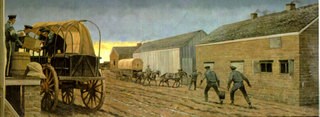
Supplies could not move efficiently when there were no roads; and the Quartermaster quickly found himself accountable for maintaining sections of the military road which connected Fort Leavenworth and Fort Gibson. With so much material being hauled overland, Swords was diligent in repairing the roads over which his equipment and supplies could be moved, but the elements sometimes were against him. 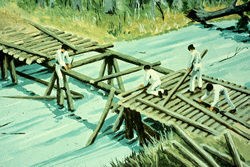
The spring and summer of 1844 were rainy and the roads became quagmires. The rivers, higher than ever before, tore away the bridges that forded them. The military road to Fort Leavenworth, completed to Spring River for a distance of 170 miles, crossed a number of rivers and streams. Most of the bridges were carried away or were so badly damaged as to be unsafe. The only direct communication, "from the North-west part of Missouri, Iowa &c. to Arkansas and Texas," the road had become a route used by emigrants, and Swords was ordered to restore the road and its bridges, particularly the one over Sugar Creek. Three trips were required before the road was restored. Partly because of the difficulty in transporting supplies over the wet morass western prairies became in the spring, Captain Terrett submitted a special requisition for a "pontoon" wagon to be used by Company A of the Dragoons. General Kearny approved the requisition in December 1843; and in the spring, two wagons were purchased from Joseph Murphy of St. Louis for $180 each, including cover, feed trough, lead bars, etc. This wagon maker built the famous Murphy covered wagons, which were used in the West much as the higher, swayback Conestoga wagon had been used in the East. The pontoon wagon was an invention of Jesup and involved the use of India rubber cloth, was capable of sustaining heavy loads afloat and was intended to afford a ready means of crossing rivers while on the march. The Quartermaster Department authorized its use in 1837, and the wagons were use experimentally during the Florida wars. Later, the wagon saw duty during the Mexican conflict. They were intended to be used only as light transports and not as regular haulers, however, and when used as the latter tended to break down. A Forage and Wagon Master was essential; and shortly after his arrival, Swords suggested that Thomas W. Higgins, who had served as Quartermaster Sergeant in the 1st Regiment of Dragoons, be appointed to the position. Higgins was a master builder and had been with Swords at Leavenworth. The recommendation of Swords was not accepted, and on September 7, Mr. John McKee, Jr. was ordered to report to Camp Scott as Wagon and Forage Master. When McKee left in 1844, Swords wanted to hire John Stook, but he again was overruled and W. Meek was employed. By fall in 1845, Swords was complaining of the profligate character of the man and asking that he be removed. The subject was touchy, because Meek was the personal appointment of General Jesup, who apparently was impressed by Meek's "gallantry during the last war." Not until the next year was Meek finally relieved. 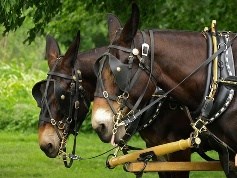
To supply the dragoon horses and animals used by the Quartermaster Department, large amounts of hay, corn and oats were needed. Fortunately there were settlers in the area, who were able to bid on the contracts for furnishing forage. In 1842 Daniel Waldo delivered 12,000 bushels of corn at 29 ¾ cents a bushel to Fort Scott, a considerably lower rate than had been asked by five other bidders, one of whom had a top bid of 47 cents. Prices rose over the years, however, and in 1845, Swords accepted a low bid from D. Johnson for 800 bushels of corn at 45 cents a bushel. Storing the corn and oats was a problem, for as late as 1847, there were no cribs at the post. Hay was more easily obtained, but in 1847, the Quartermaster faced with having two companies of mounted volunteers wintering at the post, had barely enough hay on hand to feed his own horses, mules, and oxen. Although he issued proposals for bids on hay immediately, the Quartermaster reported the "season is far advanced, and the prairies on fire all around us," which explained the prices asked. The blacksmith shop at the post was supervised by the Quartermaster, who at times had as many as two smiths working for him. When fresh animals were needed, the Quartermaster Department paid for them. Swords purchased " some very good horses of at least an average quality for $50," in 1844, while other prices for sound horses ranged from $65 for a sorrel to $45 for a black, bay or gray. Worn out or sick animals were sold at auction. In the third quarter of 1844, alone, a Board of Survey inspected eight horses, 19 mules, 38 oxen (three of which had died) and declared them useless. Dragoons often became very attached to their mounts and parted with them only with difficulty. Quartermaster returns carried liniments and salves to use on sick and galled animals, but there was no veterinary service at this time. Transportation Between 1842 and 1853, the major routes of transportation which affected the operation of Fort Scott were the Missouri River and the military road. The majority of the supplies that were necessary to build and maintain the fort were transported by steamboats on the Missouri River from St. Louis to Fort Leavenworth and then they were transported in freight wagons to Fort Scott by way of the military road. 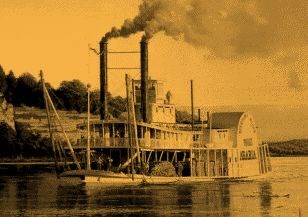
By the 1840s, there was regular steamboat traffic on the Missouri River between Fort Leavenworth, Westport (Kansas City) and St. Louis, except during the winter when the river was closed by ice. The river was very difficult to navigate because it was extremely shallow and the current constantly changed the depth and location of the shipping channel. The use of steamboats as a means of transportation was very practical and economical, but it was also very dangerous. Two of the most common causes of steamboat disasters were the explosion of the vessel's boilers from excessive pressure, and colliding with submerged logs which penetrated the hull of the vessel and caused it to sink. 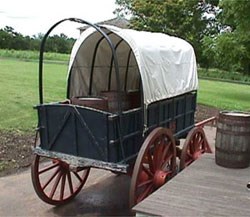
The primary means of overland transportation in the 1840s was accomplished by the use of domesticated animals (oxen, horses, and mules), wagons, carts and miscellaneous wheeled vehicles. The oxen, draft horses and mules were normally used to pull the heavy freight wagons (Conestoga, Murphy, and Halladay) that transported large quantities of supplies and materials. The smaller vehicles (road wagons, carts, and Dearbon wagons) were pulled by lightweight horses which could also be used for riding. The blacksmith, wheelwright, farrier, harness maker, and saddler were the principle trades that were necessary to maintain the wagons and animals that were used in overland transportation. In the larger cities, each tradesman normally had his own shop or business, but on the frontier one man was often skilled in many trades (i.e. blacksmith, farrier, and wheelwright). The blacksmith produced tools, nails, hinges, and other necessary items from iron and steel. A farrier was a blacksmith who specialized in shoeing horses, oxen and mules. The wheelwright was a specialist who made wagon wheels of all sizes and could often make an entire wagon. The harness maker and saddler were tradesmen who produced different types of leather saddles, bridles, halters, and harness that were necessary for the proper efficient use of the appropriate animals.
The information for this section was taken from the Historic Furnishings Report for the Quartermaster Storehouse at Fort Scott by Sally Johnson Ketcham and from an article written by an anonymous staff member at Fort Scott National Historic Site.
|
Last updated: October 11, 2017

